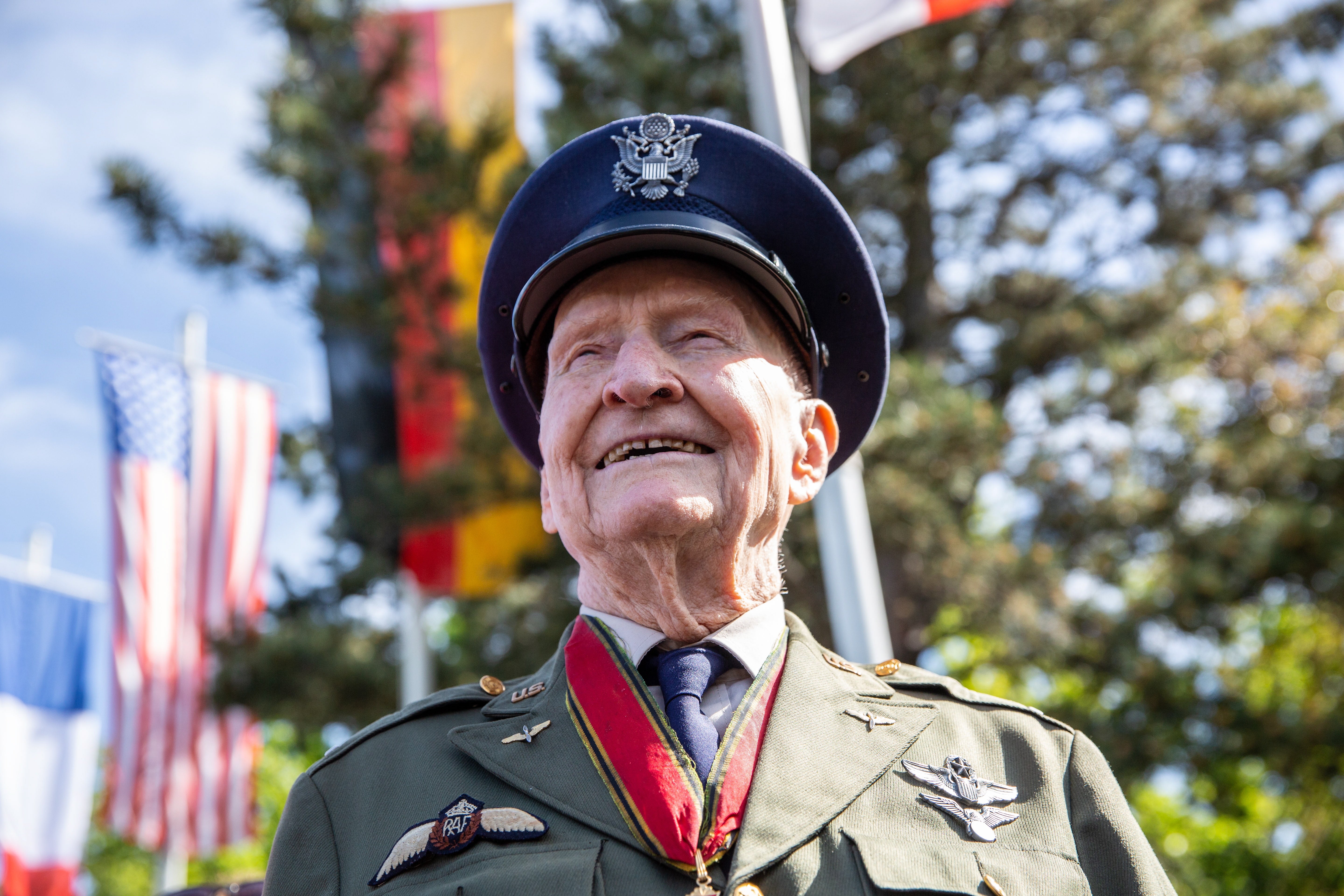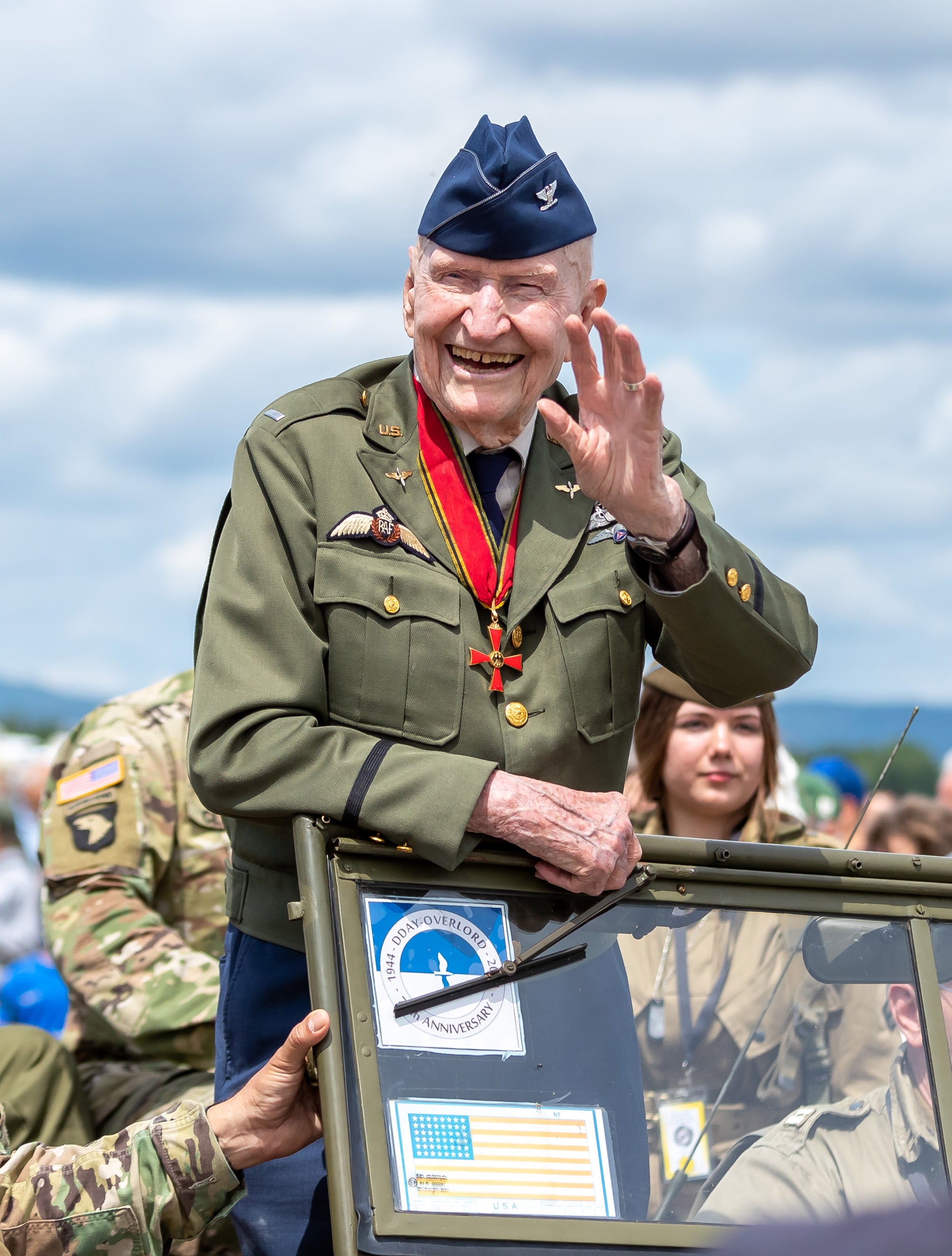Gail Halvorsen: ‘Candy Bomber’ who dropped sweets for East German children
The pilot’s act of kindness helped inspire a mission that resulted in thousands of sweets being dropped into the beleaguered country

Gail “Hal” Halvorsen, an air force pilot whose gesture of kindness during the Berlin airlift – sending tonnes of sweets fluttering down from the sky to the city’s children – endured as a redeeming moment amid the aggressions of the Cold War, has died aged 101.
Halvorsen, who retired at the rank of colonel after a three-decade career in the air force, was a 27-year-old lieutenant when he embarked on the mission that would earn him the adoration of thousands of children in Berlin and the gratitude of two countries, Germany and the United States, for his role in healing the wounds of the Second World War.
After the war, the defeated state of Germany was partitioned into zones administered by the victorious Allies. The American, British and French sectors combined to form West Germany. The Soviet sector became East Germany. Within East Germany lay the city of Berlin, which was also divided into two sections, East and West, which were eventually separated by the wall that came to represent the “Iron Curtain” that had fallen across Europe.
From June 1948 to May 1949, in one of the first major confrontations of the Cold War, Moscow blockaded West Berlin, shutting off rail and road access to that part of the city. More than 2 million citizens, deprived of food, fuel, medical supplies and other basic necessities, faced starvation.
The Berlin airlift, one of the largest humanitarian aid missions ever undertaken, circumvented the Soviet blockade by delivering goods to West Berlin by plane. More than 278,000 flights into Berlin – including 190 by Halvorsen, The Washington Post reported in 1998 – delivered more than 2 million tonnes of supplies to the city over 15 months. The accounting of casualties varies, but at least 70 American and British airlifters were killed during the operation, which ran day and night in often hazardous conditions, with planes sometimes landing every three minutes.
Halvorsen, who had been fascinated by flight ever since his days growing up on his family’s farms in Idaho and Utah, volunteered to fly in the airlift. He was making a delivery at Tempelhof airfield in West Berlin in July 1948 when he encountered a group of 30 children on the other side of a barbed wire divide.
“I saw right away that they had nothing and they were hungry,” he told the Post decades later. “So I reached into my pocket and pulled out all that I had: two sticks of gum.” The gum was enough for only four children, but even the fragrance of the wrappers delighted the others.
In a promise that seemed like the stuff of fairy tales, Halvorsen pledged to the children that he would return the next day and drop chocolate and other sweets from the sky. They would recognise his plane among the many others buzzing the city, he told them, because he would wiggle his wings.
This “took some translating”, Halvorsen, who became known to the children as Uncle Wiggly Wings, recalled years later to NBC News. “But then they said, ‘Jawohl! Jawohl!’”
Halvorsen returned to his base, collected sweet rations from his fellow airmen, and attached them to handkerchiefs. “A jubilant celebration” followed the next day, he recalled, when the miniature parachutes floated down to earth.
Halvorsen continued making the sweet drops, attracting increasing numbers of children, until a German journalist took note and published an article about his escapades. Halvorsen had not consulted his superiors about his sweet missions, reasoning that bureaucratic red tape would do little to improve the lot of the children of Berlin.

Apprised of Halvorsen’s actions, a commanding officer dressed him down, admonishing him that pilots were not to make unauthorised drops. A court martial appeared to be on the table. But then the officer told him to carry on. It was a “good idea”, Halvorsen recalled him saying – one that cultivated enormous goodwill within Germany.
“You have to remember, these were kids five, six, seven, eight years old, who had never tasted a piece of candy before, never tasted a piece of chocolate,” Halvorsen told NPR in 2008. “Their only experience with America at this age was the country that had bombed them during the Second World War, in many cases killed many of their relatives, and then occupied them in a rather harsh occupation in the years afterwards. And suddenly, here was falling from the heavens, literally, this Hershey bar or this Wrigley gum.”
Halvorsen’s private project grew into an official mission named Operation Little Vittles (the Berlin airlift as a whole was known among American forces as Operation Vittles). American sweet manufacturers donated tonnes of sweets for the effort, which quickly drew headlines and cheers on either side of the Atlantic. By the end of the airlift, pilots had dropped a reported 23 tonnes of sweets over West Berlin.
For the children who received them, those sweets held meaning no tiny, crinkled sweet wrapper could contain.
“There was no food or clean water in Berlin; we were starving to death,” Ingrid Azvedo, one of the beneficiaries of Halvorsen’s good deeds, told the Post in 2020. “Then along came this tall and skinny pilot, who reached into his pocket to give us all that he had. A kindness like that stays with you for a lifetime.”
Gail Seymour Halvorsen was born in Salt Lake City on 10 October 1920, the son of sugar beet farmers.
He received a scholarship to obtain a private pilot’s license in the fall of 1941, shortly before the Japanese attack on Pearl Harbor that precipitated US entry into the Second World War. He joined the Civil Air Patrol, the official auxiliary of what became the Air Force, and then the Army Air Forces, serving during the war as a transport pilot in the South Atlantic.
After the Second World War, Halvorsen enrolled at the University of Florida, where he received a bachelor’s degree in aeronautical engineering in 1951 and a master’s degree in engineering in 1952. He worked during his air force career as an engineer in the space programme, and returned to Tempelhof airbase as a commander.
After his military retirement, he worked at Brigham Young University in Provo as a dean of student life.
Halvorsen’s first wife, whose birth name was Alta Jolley, died in 1999 after nearly 50 years of marriage.
Survivors include his wife of 22 years, Lorraine Pace Halvorsen of Green Valley, Arizona; five children from his first marriage; and many grandchildren and great-grandchildren.
Halvorsen’s story was documented in the book The Candy Bombers: The Untold Story of the Berlin Airlift and America’s Finest Hour (2008) by Andrei Cherny. Halvorsen later wrote a memoir with his daughter Denise, which was published in 2017.
A “candy bomber” to the end, Halvorsen participated in a flight that dropped sweets over the war-torn Balkan territory of Kosovo in the late 1990s. In a commemoration of the 50th anniversary of the Berlin airlift, he co-piloted a plane that made more sweets rain down over the (by then unified) city.
He was overcome with emotion, all those years later, when he thought back and reflected on what the sweets must have meant to the children on the ground in 1948 and 1949.
“You'd be walking along in the fog, and through the clouds came a little parachute with a fresh piece of chocolate,” he told the Post. “It was a symbol of hope that somebody out there realized you were under siege ... I think hope is the thing, not the candy bar. It was the hope.”
Gail Halvorsen, former command pilot, born 10 October 1920, died 16 February 2022
© The Washington Post

